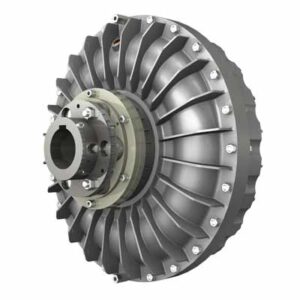Question: Except VFD drive, is there any fluid coupling replacement available in the market?
Answer: Yes! There is a fluid coupling replacement now. It’s name is magnetic coupling.
What is a fluid couping?
A fluid coupling is a mechanism that allows torque to be transmitted between two shafts. It consists of a large number of discs or plates that are alternately connected to the two shafts and either fixed or free to rotate relative to them. The rotating parts are “fluid” in the sense that they contain gear oil.
The most common type of fluid coupling has two identical sets of discs, which are called “faces.” Each face has three openings through which oil can flow from one side of the face to the other: one entrance hole and two exit holes. As one face rotates relative to another, oil flows through the entrance hole into an internal cavity that contains the gears or other components. On this cavity’s opposite side is another opening, which leads back out to a passage in which oil flows out of the coupling and returns to its original container.
Disadvantages of fluid couplings
Leaking oil
The main disadvantage is that fluid coupling is prone to leaking oil. Oil leaks are often hard to detect because they may come from under the machine or inside the machine’s housing where no one can see it unless they open up the machine completely. If this happens, you will need to replace your current system with something else before it can be used again (which could cost hundreds of dollars). And it make another issue, that is oil. The fluid coupling uses oil as a medium to transfer torque from one shaft to another. The problem with this is that the oil needs to be changed regularly, which can be quite expensive.
Many maintenance items
Another disadvantage of fluid coupling is maintenance. The fluid within the device must be maintained at all times in order to ensure proper operation and optimal performance. This means that regular maintenance checks must be performed both on the machine itself as well as on any devices used in conjunction with it (such as pumps).
High maintenance cost
The third disadvantage of fluid couplings is the amount of time it takes to install them and maintain them. A fluid coupling requires extensive maintenance and regular inspection. In addition, installing a fluid coupling can take several hours or even days depending on its size and complexity. This makes it difficult to use on machines that need to be set up quickly or moved frequently. That is a big problem for some companies. On average, the use of fluid coupling production lines, down to a year, nearly 15 days of production stoppages. This is a huge loss for companies such as coal mines and cement plants.
Additionally, the fluid coupling does not provide much power and is therefore not ideal for high-torque applications. It also has a limited speed range compared to other types of couplings.
What is magnetic coupling?
A magnetic coupling is a mechanical device that transfers rotational motion from one shaft to another. Magnetic couplings are typically used in machines that operate under high speeds and heavy loads. The two shafts, which can be as long as several feet in length, must remain parallel to each other at all times during the coupling process.
The magnetic coupling uses an magnetic field to transfer rotational motion from one shaft to another without any contact between them. The two shafts are placed in close proximity with their respective bearings held in place by clamps. Magnets embedded in each bearing attract and repel each other, allowing for the transfer of energy from one shaft to another without having any direct contact between them.
Why it is the best fluid coupling replacement?
The magnetic coupling is the best fluid coupling replacement. Because it has below advantages over other types of couplings:
No grease
First advantage is it does not require any maintenance—you don’t have to worry about oil or grease, making it a low-maintenance solution for your machine.
The magnetic coupling system is a simple way to transfer power from one component to another without any need for maintenance or adjustment. The only thing you need to do is make sure that the two components are clean and dry before placing them together, so as not to cause any corrosion between them.
Easily to install
It can be easily installed on any type of machine, from small parts to large equipment.
The magnetic coupling is an innovative solution to a common problem: aligning two objects. Magnetic couplings provide a way to connect two objects without the need for precise alignment. The strength of the magnetic field is enough to hold the objects together, but not so strong that it will damage them if they are accidentally knocked together.
This makes magnetic couplings ideal for applications where precise alignment is not necessary, such as holding machine parts together while they are being assembled or allowing pieces of equipment to be easily moved around an area
About disadvantages of magnetic coupling
Lots of the people says the only disadvantage of magnetic coupling is it’s cost. They think magnetic couplings are more expensive than other types of couplings.
In fact, that is not ture.
If you take into account the production stoppages loss caused by the fluid coupling, the cost of the oil that needs to be added and changed every year, the cost of maintenance engineers, and the time of use, the life of the fluid coupling is 8 years, and the magnetic coupling is 20-30 years. In this way, the price difference between the two is not much.
Contact our sales engineer today to know more about the magnetic coupling.


